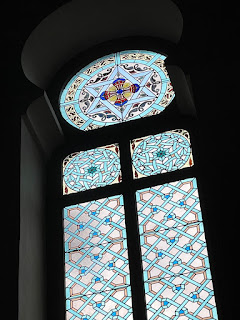The Lorca House and other buildings
In Granada
There’s an American children’s classic, written in the 1940s, called The Little House. It tells the story, with delightful and clever illustrations, of the eponymous dwelling, built in isolation in the countryside.
Gradually come roads, more houses, more urban infrastructure, until the little house stands neglected on a sorry city lot between two apartment blocks.
One day a descendant of the original builder spots the house, takes pity and arranges for it to be transported on a flatbed trailer to a northern unspoilt country location. The End.
The story is similar to that of the Lorca family’s house in Granada. The father of Federico Garcia Lorca purchased the place as a country home, then outside the City, on the vast and fertile Vega, or west-lying plain. The house is not grand but hardly little – a residence for a prosperous bourgeois family, surrounded by an elegant garden. It was named the Huerta San Vicente. Lorca spent most summers of his life there, and it was where he produced much of his written work.
After Federico’s murder, near Granada, in 1936, the family still retained ownership, although the principal surviving members went into exile during most of the Franco years. Low profile friends or relatives occupied the property on behalf of the family.
In the 1970s Granada began a great urban expansion. Pretty soon the new suburbs came calling for the Huerta. A new by-pass motorway hemmed in its western side. All was nearly loss to redevelopment.
But the political climate changed: Federico Garcia Lorca was once again embraced as a great Spanish writer. A combination of the Lorca family’s wish to preserve Federico’s legacy and the City’s wish to honour its native poet led to the donation of the house and garden to a special civic institution and the creation of a park to contain both. The sprawl of Granada lapped round but not over the park, which is now an oasis in an unlovely desert of built-up suburb and busy roads.
The house is modestly furnished, with an interesting selection of Lorca memorabilia. It is similar in many ways (but larger) to the home of Lorca’s musician contemporary and friend, Manuel de Falla, which is tucked into the side of the Alhambra’s plateau (with a view towards the Huerta, but for the cityscape).
These house-museums of two C20 cultural figures are indeed chaste and utilitarian compared to Granada’s earlier grandiosity after the Reconquista. (The Alhambra palace itself, even earlier, has an elegant purity of design and building now appreciated after some centuries of neglect.) One cannot help but have reservations what was built in Granada in the three centuries after 1492.
The Cathedral is magnificent- unusual in its wide footprint, so that the first and continuing impression is one of unusually vast spaciousness. Just after entering, I thought I was in central nave, only to realise a moment later that I had been in a side nave, big enough for most cathedrals’ central one. There are indeed five naves instead of the usual three.
The space swirls round the back of the main altar and allows for two large organ ensembles. The decoration and architecture is elegant and for the most part restrained, although in places there are somewhat discordant elaborations typical of early modern Spanish churches.
But..whilst the Cathedral is a fine example of “Spanish renaissance”, walk a little further north-westwards and there two examples of churches teetering on the edge of excess or going, to my sensibility, very wrong.
The church of the San Jerónimo Monastery (now home to reclusive nuns) is a vivid example of renaissance decorative art, inspired by and dedicated to the memory of the El Gran Capitan, the general from Cordoba who led the final stages of the Reconquista. He is buried in the church. The church more celebrates the Gran Capitan than the Great Captain in the Heavens Above, and is none the worse for that.
A short distance away is the C18 baroque basilica dedicated to San Juan de Dios, a worthy saint who founded hospitals. But his Basilica (an honorific conferred by the Vatican) is a cloying riot of rampant over decoration , ghastly images and a horrific bony reliquary. Quite where San Juan’s care for the sick fits in with this confection is difficult to discern.
Up on the Cartuja hill in the north east of Granada sits a large building put up by the Jesuit Order at the end of the nineteenth century, for educational purposes (scientific training for priests). It is now fittingly part of the University of Granada’s local campus.
The chapel of the building, now decommissioned, is interesting because it is a Catholic Church built in neo-mujedar style. Its windows, doors and decorative tiling would not be out of place in a mosque in El-Andalus.
What goes around, comes around, at least in architecture.
March 2025















No comments:
Post a Comment